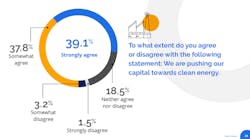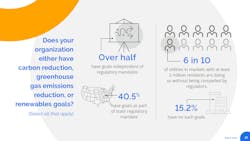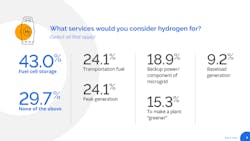Utility Challenge: Plan and Pay Now for Tomorrow's Decarbonization
As decarbonization deepens around the globe, power providers are being pressed to invest in what's emerging as the evolving energy landscape's future — cost-effective, low-, or zero-emission energy that can be readily integrated into a more modernized, distributed grid.
It's a transformation stoked by consumers and other stakeholders demanding lower-carbon energy options, making the surging use of renewables and distributed energy resources (DER) opportunities to ensure reliable, clean, and affordable power.
Such tides of change are forcing power utilities — accustomed to thinking in terms of 30-year planning horizons — to reimagine their generation portfolios with a keener, more immediate focus on ridding their operations of planet-warming emissions. As the world turns more dynamic and fast-paced, utilities now must respond faster than ever imagined.
Although renewable energy has reached cost parity with traditional energy supply options in many markets, their natural intermittency may complicate efforts to maintain grid reliability when they account for a significant portion of the energy supply stack. Pursuing robust decarbonization through renewables — including hydrogen, a potentially game-changing energy source that's still evolving — will be a complicated endeavor, requiring collaboration between consumers, investors, activists, and regulators.
Possible volatility and uncertainty remain in what had been a relatively predictable industry — most certainly when it comes to forecasting power demand, compounding the challenges of regulatory changes, and activist investors enjoying a bigger shareholder voice and demanding swifter shifts to renewables.
Given all of that, a reality has emerged: planning by utilities must begin now, knowing that complacency can be a curse as more and more consumers expect their power providers to be progressive and proactive.
As Coal Falters, Industry Awakens to Need for Investment
On the heels of coal-fired power production's plunge in 2019 to its lowest level in more than four decades, the Energy Information Administration (EIA) expects electricity from solar and wind sources to continue their ascendancy, accounting for 70% of new energy production this year in the United States. The agency, in its latest short-term outlook released in January, projects that of 39.7 GW of new capacity anticipated to come online by 2022, a record 15.4 GW will come from solar, surpassing last year's 12-GW increase. Wind will account for an additional 12.2 GW domestically, down roughly 9 GW from 2020.
Battery storage — increasingly used in tandem with renewables — will more than quadruple this year in the United States, with 4.3 GW of battery power capacity additions slated to come online this year, the EIA submits.
Perhaps not coincidentally, electric industry players are taking note and taking action.
According to Black & Veatch's latest Strategic Directions: Electric Report, based on a survey of more than 600 industry stakeholders, more than three-quarters of respondents agree that they are devoting more of their capital spending to clean energy (Fig. 1).
Fanning the push toward renewables is growing regulatory or legislative pressure state by state to find a cleaner, greener way of doing business.
Not to be outdone, industry leaders such as Microsoft, Jacobs, and Amazon have pledged to be zero carbon or carbon negative in their supply chains and operations. Some of the most influential firms are not waiting on policy changes and have chosen to solidify their clean energy commitments via the RE100, a list of companies — among them General Motors, Hewlett-Packard, Iron Mountain, Johnson & Johnson, and Kellogg's — that have announced plans to move to entirely renewable power generation. Black & Veatch, a leading global provider of energy solutions, recently joined others in the sector in announcing its decarbonization plan that no longer involves work on future coal-related projects, and the company has set a goal to get its overall emissions to net zero by 2025.
Compiled by the Climate Group and CDP (formerly the Carbon Disclosure Project), the lineup of more than 280 participating companies — many in the commercial and industrial (C&I) space — are intent on generating their own energy through rooftop solar or buying renewable-based power from offsite, grid-connected generators. By 2030, RE100 companies will need to purchase more than 220 TWhs of additional clean electricity — nearly as much as the energy consumption of Australia — to meet their stated targets.
Promisingly, respondents to Black & Veatch's survey overwhelmingly say they're actively blueprinting how to lower their carbon footprints or deploying more renewables. More than half say they're doing so voluntarily, roughly 13 percentage points more than those attributing their efforts to a state regulatory mandate (Fig. 2).
On Jan. 12, 2021, for example, Minnesota Power announced its vision to deliver nothing but carbon-free energy to its 145,00,000 residential and commercial customers in northern Minnesota by 2050. The utility, which already is halfway to that goal, says its strategy to be reviewed by state regulators involves expanded wind and solar resources, coal-free operations at its facilities by 2035, and an investment in a more resilient, flexible transmission and distribution (T&D) grid.
"As a clean energy leader, we are meeting the challenge of climate change with a reliable energy supply while keeping costs affordable for customers in this region," said Bethany Owen, president and CEO of Minnesota Power, corporate parent ALLETE Inc. "For Minnesota Power, this plan is about more than achieving the most significant sustainability goal in our long history — it is about becoming 100% carbon-free the right way."
Perhaps given their deeper pocketbooks, the biggest utilities — serving at least two million residents — are most likely to voluntarily invest in emissions reduction or renewables goals, with nearly 6 in 10 respondents saying they're doing so without being compelled by regulators. Some 46% of respondents from utilities serving 500,000 to two million people say their carbon-reduction goals are part of a state regulatory mandate.
As providers of roughly one-third of U.S. retail electricity sales, smaller utilities — typically municipal or co-operative enterprises in markets with fewer than 500,000 people — appear to be the laggards, with 3 in 10 of those respondents admitting they have no carbon-cutting game plan. Possible drivers of that could be their unfamiliarity with the technology, risks, and operating characteristics — and perhaps a misperception of costs, which can be mitigated through self-financed methods or power purchase agreements (PPA). Smaller utilities are also often managed by elected boards reluctant to raise rates or that simply may be willing to wait until a new technology and the business case for it is more proven. Simply put, the cost and the environment must be right.
Collaboration: A Key to Decarbonization
The Electric Power Research Institute (EPRI) and the Gas Technology Institute (GTI) have unveiled a five-year global effort to hasten the development and demonstration of low-carbon energy technologies. With 19 collaborating sponsors in the electric and gas sectors, that Low-Carbon Resources Initiative (LCRI) is targeting advancements in low-carbon electric generation technologies and energy, including hydrogen, ammonia, synthetic fuels, and biofuels. Rather than shun natural gas altogether, the LCRI has created a critical collaboration between the electric and gas industries to achieve broader energy and decarbonization objectives.
Among other things, the collaborative will identify and accelerate fundamental development of promising technologies, demonstrate and assess the performance of key technologies and processes, and inform key stakeholders and the public about technology options and potential pathways to a low-carbon future.
"Achieving ambitious targets will require technologies and processes beyond those widely available today," said Arshad Mansoor, the EPRI's president, in a statement. "This global initiative will advance affordable pathways to economywide decarbonization."
Hydrogen: Tomorrow's Answer?
In many countries, utilities have been aggressively exploring the introduction of hydrogen into their generation mixes, using renewable-powered electrolysis to cull the element from water. The United States has been slower to deploy gas as a power source, likely because of cost competitiveness concerns.
But that mindset appears to be changing as hydrogen-generated power, complemented by fuel cell storage, is drawing increasing acclaim for its promise, given solar and wind energy's intermittency that raises concerns about grid reliability. Opportunities to leverage existing natural gas and ammonia infrastructure to produce and deploy hydrogen at scale are being explored enthusiastically by a broad coalition of industry participants.
The Black & Veatch survey illustrates that over the next decade, utilities expect solar (79%) and wind (67%) power to help them meet their clean energy goals or cut their emissions and carbon output, presumably because those options have established, matured technology and competitive costs. Those numbers drop into the 40th percentiles beyond 10 years, giving way to more deployments of hydrogen (58%) and battery energy storage (48%) amid expectations that the costs of those technologies at scale will continue to decline (Fig. 3).
When asked specifically about the services for which they would consider hydrogen, more than 4 in 10 respondents said they would consider it for fuel cell storage, nearly double those who cited its potential use for transportation fuel for fleets and as an option for peak power generation. For now, fewer than one-fifth said they see it as a source of backup power or a component of a microgrid (Fig. 4).
As private investment in clean energy continues to grow globally, electric utility planners and regulators will need to adapt their forecasts and investments accordingly. This will require more rapid design and development, as well as collaboration with interested stakeholders and investors.
In Part 3 of this three-part series, additional experts will discuss 'Old Utility Problems Raise Interest in New Technologies.'






